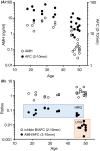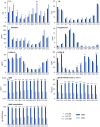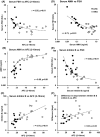Interactions between serum FSH, inhibin B and antral follicle count in the decline of serum AMH during the menstrual cycle in late reproductive age
- PMID: 33855196
- PMCID: PMC8029535
- DOI: 10.1002/edm2.172
Interactions between serum FSH, inhibin B and antral follicle count in the decline of serum AMH during the menstrual cycle in late reproductive age
Abstract
Objective: To investigate the hormonal interrelationships during the menstrual cycle in women of late reproductive age with suppressed serum AMH and antral follicle count (AFC).
Methods: Serum hormones (AMH, FSH, LH, estradiol, progesterone, inhibin A, inhibin B), AFC (2-10 mm) and AMH/AFC ratio (an estimate of AMH/follicle) were assessed every 2-3 days across the menstrual cycle in 26 healthy ovulatory women aged 18-50 years.
Results: An 11-fold fall in AMH/AFC was observed in women aged ≥45 years compared to those 18-45 years (P < .001). Although women ≥45 years exhibited normal menstrual cycle patterns of serum estradiol, progesterone, LH and inhibin A, FSH was elevated (P < .001) and inhibin B suppressed (P < .001) compared to the younger group. Overall FSH was inversely correlated (r = .55, P < .05) and AMH directly correlated (r = .88, P < .01) with AFC; however, these relationships were curvilinear and more pronounced when AFC was low. Inhibin B was directly linearly correlated (r = .70, P < .01) with AFC across both high and low AMH/follicle groups.
Conclusions: It is hypothesized that the marked fall in AMH/follicle in late reproductive age is attributed to the change in the hormonal interplay between the pituitary and ovary. The fall in AFC leads to a decrease in inhibin B and a concomitant increase in FSH by a recognized feedback mechanism. It is postulated the elevated FSH suppresses AMH either directly or indirectly through oocyte-specific growth factors leading to a marked fall in AMH/follicle. We propose that pituitary-ovarian and intra-ovarian regulatory systems underpin the accelerated fall in AMH/follicle during the transition to menopause.
Keywords: BMP15; GDF9; cumulin; estradiol; inhibin A; menopause; oocytes.
© 2020 The Authors. Endocrinology, Diabetes & Metabolism published by John Wiley & Sons Ltd.
Conflict of interest statement
The authors have nothing to disclose.
Figures




Similar articles
-
Anti-Mullerian hormone, inhibin B, and antral follicle count in young women with ovarian failure.J Clin Endocrinol Metab. 2009 Mar;94(3):786-92. doi: 10.1210/jc.2008-1818. Epub 2008 Dec 9. J Clin Endocrinol Metab. 2009. PMID: 19066296
-
Anti-müllerian hormone is a promising predictor for the occurrence of the menopausal transition.Menopause. 2004 Nov-Dec;11(6 Pt 1):601-6. doi: 10.1097/01.gme.0000123642.76105.6e. Menopause. 2004. PMID: 15545787
-
Dynamic assays of inhibin B, anti-Mullerian hormone and estradiol following FSH stimulation and ovarian ultrasonography as predictors of IVF outcome.Hum Reprod. 2005 Nov;20(11):3178-83. doi: 10.1093/humrep/dei203. Epub 2005 Aug 19. Hum Reprod. 2005. PMID: 16113044
-
A review of hormonal changes during the menopausal transition: focus on findings from the Melbourne Women's Midlife Health Project.Hum Reprod Update. 2007 Nov-Dec;13(6):559-65. doi: 10.1093/humupd/dmm020. Epub 2007 Jul 14. Hum Reprod Update. 2007. PMID: 17630397 Review.
-
Hormone changes associated with the menopausal transition.Minerva Ginecol. 2009 Dec;61(6):483-9. Minerva Ginecol. 2009. PMID: 19942836 Free PMC article. Review.
Cited by
-
The Relationship Between Serum Anti-Müllerian Hormone and Basal Antral Follicle Count in Infertile Women Under 35 Years: An Assessment of Ovarian Reserve.Cureus. 2023 Dec 8;15(12):e50181. doi: 10.7759/cureus.50181. eCollection 2023 Dec. Cureus. 2023. PMID: 38077683 Free PMC article.
-
Follicular challenge test to predict suboptimal response to gonadotropin releasing hormone agonist trigger in elective oocyte cryopreservation cycles.Sci Rep. 2024 Mar 14;14(1):6204. doi: 10.1038/s41598-024-56418-2. Sci Rep. 2024. PMID: 38485977 Free PMC article.
-
Serum FSH as a Useful Marker for the Differential Diagnosis of Ovarian Granulosa Cell Tumors.Cancers (Basel). 2022 Sep 15;14(18):4480. doi: 10.3390/cancers14184480. Cancers (Basel). 2022. PMID: 36139639 Free PMC article.
-
Genetic Prediction of Osteoporosis by Anti-Müllerian Hormone Levels and Reproductive Factors in Women: A Mendelian Randomization Study.Calcif Tissue Int. 2024 Jul;115(1):41-52. doi: 10.1007/s00223-024-01220-5. Epub 2024 May 14. Calcif Tissue Int. 2024. PMID: 38743269 Free PMC article.
References
-
- Faddy MJ. Follicle dynamics during ovarian ageing. Mol Cell Endocrinol. 2000;163:43‐48. - PubMed
-
- Dewailly D, Andersen CY, Balen A, et al. The physiology and clinical utility of anti‐Mullerian hormone in women. Hum Reprod Update. 2014;20:370‐385. - PubMed
-
- Durlinger AL, Kramer P, Karels B, et al. Control of primordial follicle recruitment by anti‐Müllerian hormone in the mouse ovary. Endocrinology. 1999;140:5789‐5796. - PubMed
-
- Durlinger AL, Gruijters MJ, Kramer P, et al. Anti‐Müllerian hormone attenuates the effects of FSH on follicle development in the mouse ovary. Endocrinology. 2001;142:4891‐4899. - PubMed
Publication types
MeSH terms
Substances
Grants and funding
LinkOut - more resources
Full Text Sources
Medical

